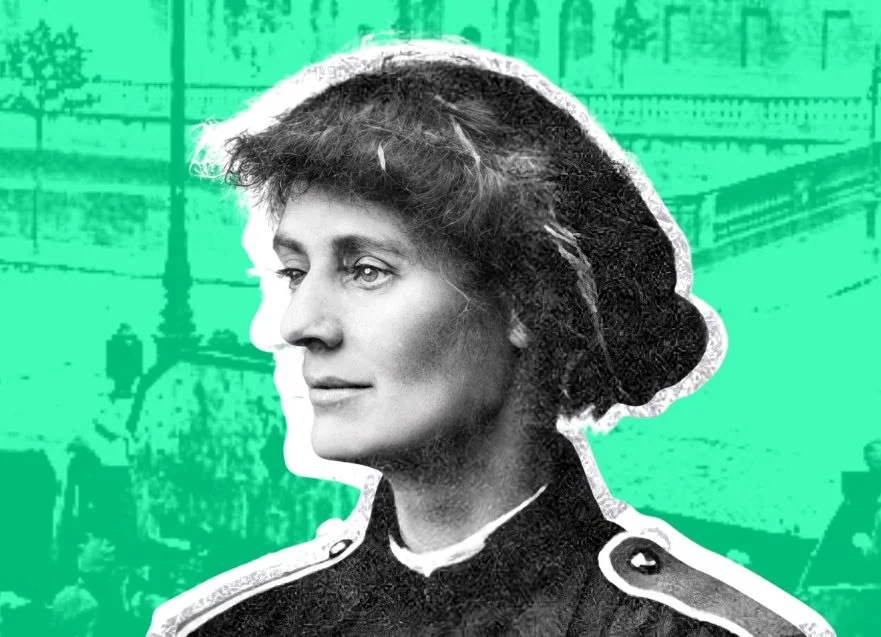On The Shoulders of Giants . . . 'Stop Thief' - Constance Markievicz
This month marks the 96th anniversary of the death of Irish socialist republican revolutionary, Constance Markievicz. To commemorate this occasion, and as part of our On the Shoulders of Giants series, we republish ‘Stop Thief’ below — a piece written by Markievicz and first published in 1923, while the counter-revolution was still in full swing.
Markievicz was incensed at the theft of Republican symbols, flags and the all-Ireland revolutionary Dáil Éireann itself by the counter-revolutionaries in their drive to dilute and replace their original meanings for the purpose of legitimising the capitulation of the Free State to British imperial interests.
W.T. Cosgrave and Kevin O’Higgins, two central figures who led the counter-revolutionary administration after the IRA order to dump arms.
Stop Thief
Constance Markievicz
Éire
17th February, 1923
Thieving on the material plane is punished very severely, and property is protected in every country by the forces of law and order. A man is more severely punished for a continual record of robbery than for wife-beating, and yet if we consider it carefully we must agree that “who steals my purse steals trash” and admit that the ordinary thief does little harm to those he robs.
Robbery on the spiritual or moral plane is far more damaging to the person robbed than the robbery of their purse or other property, and can only be inspired by the basest motives.
Today in Ireland we have a “government” giving a terrible example to the people whom they claim to be guiding of robbery on the spiritual plane. The Irish Republic is being robbed by the Free Staters, who pretend to act at all times in the name of law and order and to be “fulfilling the will of the Irish people”.
The spiritual robbery they commit daily is the stealing of our Republican symbols for the purpose of debasing them to trick and lead to their degradation the people who trusted them.
They have stolen our flag, the tricolour of the Irish Republic, the emblem under which so many great and noble men laid down their lives.
This flag was hoisted over the GPO on Easter Monday, 1916 and when the building was wrapped in flames and the O’Rahilly lay dying in Moore Street the tricolour symbol of the Republic stood stark over the roofless walls. That flag flew over every hillside, bogland and town in Ireland, and draped many a coffin.
Today the Free Staters hoist it over the barracks and jails where Republicans are tortured and officially murdered.
They have stolen the green uniform of the Volunteers, as the Irish Republican Army were first called, the uniform in which Padraig Pearse read the Proclamation of the Irish Republic, which was sanctified and consecrated by many a martyr, and in which the bodies of Tom Ashe, of Terry MacSwiney, and many another Irish Republican soldier went to their last rest.
They have stolen the badge FF of the Irish Republican Army, which stood for the ideals of the old Fianna and all that was noblest and most honourable in our nature.
They have stolen the name of ‘SAORSTAT’.
This name was accepted by us as the best Gaelic equivalent for the word Republic. MacNeill and P. Beasley, in the name of the Gaelic League, objected to the word “Poblacht” on the grounds that it was but a Latin word Gaelicised, giving us “Saorstat” in its stead. It was these men who later retranslated “Saorstat” into English as “Free State”. But “Saor” has another meaning, “Cheap” and “Cheap” State is an admirable name for a “State” whose rulers have the cheap ideals and tawdry morality of the Free Staters – men who sell their country and their comrades for position and power; men who have cheapened the value of human life till they have complacently passed a bill by which they are daily executing boys merely for carrying a revolver, which possibly they may never have used; men who shoot prisoners of war as a reprisal for the acts of other men, unknown men, notwithstanding the fact that these prisoners had been guaranteed the “treatment of prisoners of war” on their surrender.
They stole the name of Dail Eireann.
“Dail Eireann” had but one meaning to the people of Ireland. It is the Gaelic name by which the Parliament of the Republic was known to them. After the general election of 1918 the members elected on the Republican ticket assembled as Dail Eireann, the Parliament of the Republic, and, obeying the mandate of the people, the “First Dail” in open session issued to the world the Declaration of the Independence of Ireland. They then proceeded to set up the machinery of the Republican Government. The members took the oath of allegiance to the Irish Republic, pledging themselves solemnly before Almighty God to defend it from its enemies foreign or domestic.
The First Dail built up and maintained the Republic, and its army pressed on the English till they asked for a truce during the Terror.
The Second Dail carried on the work begun in 1918 loyally, until that tragic hour when a small majority of traitors recorded their votes in approval of the Treaty and broke their oath to the Republic.
It had been decided for convenience sake to postpone the last meeting of the Second Dail till after the general election of 1922. The business was merely routine work, which had to be concluded before the Third Dail took over the powers.
President Griffith had publicly given his word that he would keep intact the machinery of the Republic until such time as the people of Ireland decided whether they stand by it and possibly face a renewal of the war with England, or whether they would accept peace at the price of the re-establishing of British rule in Ireland in the peculiar form prescribed by the Treaty, ie the Free State. The question was to have been put before the people in a general election to be held in this spring.
Directly after the elections the men who had held office under the Second Dail, which had as the government of the country ceased to exist, shelled the Four Courts and started the war against the Republic.
In the lull that followed the shelling of the Four Courts “Dail Eireann” was called in a somewhat haphazard way. We discovered that it was not the Second Dail that was being summoned, for only the persons elected at the recent elections were bidden attend.
This roused our suspicions, and there was much discussion as to whether or not the Free Staters were deliberately calling the Southern Parliament together under the name Dail Eireann, so that the people should not find out that it was the Partition Parliament that was meeting.
Mr Ginnell attended and put the question as to whether the assembly was “Dail Eireann”, the Parliament of the Republic, or whether it was the Partition Parliament for twenty-six counties masquerading under that name. Surely the least one should expect from an assembly purporting to be the government of a country would be a courteous answer to a courteous question. Mr Ginnell, our veteran hero and former ambassador to Argentina, received no courteous answer; he was insulted and forcibly thrown out of the room.
Not one of the Free Staters had the courage to state publicly that it was the Partition Parliament for Southern Ireland in session camouflaged under the name “Dail Eireann”, the name of the Parliament of the Republic. That this was so was clearly shown when the assembly proceeded to act, as the English instrument set up under the Partition Act alone had power to do, under English law. It proceeded to pass the Treaty and the Constitution, and to set up a Provisional Government for twenty-six counties. According to the Treaty the Parliament of Southern Ireland was given the task of re-establishing English rule in Ireland and under the name of the “Free State”.
Thus the most valued of the insignia of the Republic were stolen by the Free Staters to camouflage their treachery. Her name, the title of her chief, the uniform of her brave soldiers. No wonder that the people of Ireland are still bewildered by all this dishonesty and shiftiness. The Free Staters thought indeed that they had completed their smokescreen when, on Eamonn de Valera resigning his position as President of the Republic, they elected Mr Griffith into his place. On Mr Griffith’s death the title was bestowed on Mr Cosgrove. Mr Cosgrove still styles himself President Cosgrove.
For a long time nobody asked the question, “Of what is President Cosgrove president?” They took it for granted that he was “president” in the same sense that they had learned to understand the word – President of the Irish Republic, even as President de Valera had been. The Free Staters have not yet divulged the fact that he is merely a puppet, subordinate to the English Cabinet, the Privy Council, and to the “King’s Representatives in Ireland”. An unsuspicious and trusting people naturally find it hard to believe that the title of “president” assumed by Mr Griffith and now used by Mr Cosgrove was taken and used by them to delude their own people into believing that they were still maintaining the Republic, to camouflage their efforts to subvert it, and trick them into believing that Free State is but another form of independence.
But even the most trusting of people cannot be tricked beyond a certain point. The green-clad soldiers move among them much in the way that the Black and Tans had moved, and they wonder. The tricolour floats over the jails in the place where they had been wont to see the Union Jack, and it floats over the same crowds of men and women fighting as before for the Republic, and the people question.
Rory O’Connor and three other Republican officers who surrendered after the fall of the Four Courts were executed and lie today behind the same grim walls that enclose the graves of Kevin Barry and his comrades. All died for the same cause, for the Republic; all sent the same messages of faith and trust back from the threshold of eternity, the only difference between today and yesterday being that our Irish patriots are now done to death under their own flag by men wearing their own uniform. This more than anything else has wiped the scales from the people’s eyes, washed them away with bitter tears, and they realise that the same power and the same purse are behind both sets of executioners.
And today Eamonn de Valera is again President of the Irish Republic. Again he defies the forces of darkness, and risks life and liberty daily for the country he loves.
The puppet president cowers behind the sandbags and barbed wire in Merrion Street, sustained and controlled by his masters, the British Cabinet. But his giant’s robe and his assumed dignity are surely slipping from him and the vision of Eamonn de Valera, brave President of the Irish Republic, standing firm and true to his principles, is surely piercing through the gloom and mystery that envelops the minds of the people – a great light of valour leading us to victory.


